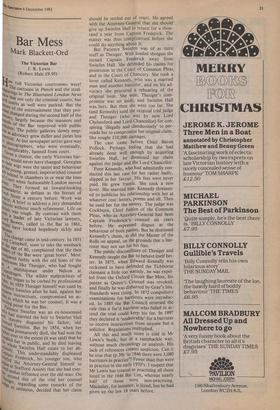Bar Mess
Mark Blackett-Ord
The Victorian Bar J. R. Lewis (Robert Hale £9.95) ew full Victorian courtrooms were!
4
en The cartoons in Punch and the steel- shgravings in The Illustrated London News tsiv°,‘Y that not only the criminal courts, but natipipe°tIrts as well were packed. But the vidZe of the entertainment that they pro-
hanged during the second half of the total' rY largely because the manners and
of the Bar improved with public tied am. The public galleries slowly emp- eu.8 advocacy grew duller and juries less t,"41tial. At last newspaper artists gave way a ji'photographers, who were eventually, ;,Irlexplicably, banned from court. tist,I,.vett a chance, the early Victorian bar- k S WoUld never have changed. Georgian Of ti:ir Wigs were the tastes and behaviour left k" Y, °lieuindng, genteel, impoverished counsel Of c' in chambers in or near the Inns 4 v°1111 when fashionable London moved Ca.; They formed an inward-looking Cruh-7,ue1ie, as defiant as the literati of sca;" treet a century before. Work was rheice. A brief to address a jury demanded c without much refinement. Life on itz-thlit was tough. By contrast with them Lord a leader of late Victorian lawyers, W041230wen, called to the Bar in 1861, eiliceune.have looked hopelessly sickly and
The 1.
Lord ,cuange came in mid-century. In 1851 !age the`atnPbell, soon to take the woolsack Ieklec,age of 80, complained that the then conc° of the Bar were 'great bores'. Most enulaared feebly with the old lions of the as rt,r0°In like Thesiger, who had fought Co„' en h midshipman under Nelson at iJ the a g geo. The wilder malpractices of rtlio, a; began to be curbed by professional l'ati'' in 1859 Thesiger himself was sued by exprenee Swinfen after he had, against her e.ss instructions, compromised an ac- ttir',.111 which he was her counsel. It was a P'In.8 Point for the Bar.
41: h0 Swinfen was an ex-housemaid "ad Married the heir to Swinfen Hall sn 111 re ,e bY disgusted his father, old slhi-lei Swinfen. But by 1854, when her fath2nd Prematurely died, she had won the fon: over to the extent (it was said) that he th-e'led her in public, and he died leaving solutwit, °le Swinfen Hall estate to her ab- C4hiselY• This understandably displeased brie'rtn Frederick, his younger son, who 4gt;,,etin the Attorney-General himself to .sed
at Stafford Assizes that she had exer-
the" undue influence over the old man. On illtsIs.econd day of the trial her counsel ik-til„ger, regarding some remarks of the — as ominous, decided that her claim
should be settled out of court. He agreed with the Attorney-General that she should give up Swinfen Hall in return for a thou- sand a year from Captain Frederick. The matter was thus compromised before she could do anything about it. But Patience Swinfen was of as stern stuff as Thesiger. With loaded shotgun she turned Captain Frederick away from Swinfen Hall. She defended his claims for possession in the Court of Common Pleas and in the Court of Chancery. She took a lover called Kennedy, who was a married man and another barrister, and on his ad- vocacy she procured a rehearing of the original issue. She won; Thesiger's com- promise was set aside, and Swinfen Hall was. hers. But then she went too far. She (and Kennedy) sued the original trial judge and Thesiger (who was by now Lord Chelmsford and Lord Chancellor) for con- spiring 'illegally and clandestinely' to per- suade her to compromise her original claim. She sought £10,000 damages. The case came before Chief Baron Pollock. Perhaps feeling that she had already done well enough by acquiring Swinfen Hall, he dismissed her claim against the judge and the Lord Chancellor.
Poor Kennedy, who had admittedly con- ducted this last case for her rather badly, slipped in her favour. His fees were never paid. He grew frantic. She took a new lover. She married him.. Kennedy threaten- ed to publicise his relationship with her at whatever cost: letters, poems and all. Then he sued her for the money. The judge was Cockburn, Chief Justice of the Common Pleas, who as Attorney-General had been Captain Frederick's counsel six years before. He expressed disgust at the behaviour of both parties. But he dismissed Kennedy's claim, as did the Master of the Rolls on appeal, on the grounds that a bar- rister may not sue for his fees.
The public discomfiture of Thesiger and Kennedy taught the Bar to behave itself bet- ter. In 1875, when Edward Keneally was reckoned to have defended the Tichborne claimant a little too warmly, he was expel- led from the Oxford Circuit Bar Mess, his patent as Queen's Counsel was revoked, and finally he was disbarred by Gray's Inn. Standards were rising.. In 1872 compulsory examinations for barristers were introduc- ed. In 1885 the Bar Council reversed the rule that a fee'd barrister who failed to at- tend the trial could keep his fee. In 1897 they declared it 'undesirable' for a barrister to receive instructions from anyone but a solicitor. Regulations multiplied.
All this and much more is told in Mr Lewis's book, but in a ramshackle way, without much chronology or analysis. His lack of references creates suspicion. Can it be true that (p.39) 'in 1846 there were 3,080 barristers in practice'? Fewer than that were in practice in the early 1970's. I suspect that Mr Lewis has treated as practising all those listed in the 1846 Bar List, whereas nearly half of those were non-practising. Macaulay, for instance, is listed, but he had given up the law 18 years before.










































 Previous page
Previous page